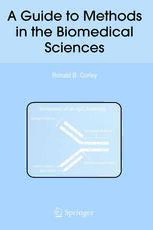
A Guide to Methods in the Biomedical Sciences PDF
Preview A Guide to Methods in the Biomedical Sciences
A GUIDE TO METHODS IN THE BIOMEDICAL SCIENCES A GUIDE TO METHODS IN THE BIOMEDICAL SCIENCES RONALD B. CORLEY, Ph.D. Boston University School of Medicine Boston, MA, USA Springer eBookISBN: 0-387-22845-4 Print ISBN: 0-387-22844-6 ©2005 Springer Science + Business Media, Inc. Print ©2005Springer Science + Business Media, Inc. Boston All rights reserved No part of this eBook maybe reproducedor transmitted inanyform or byanymeans,electronic, mechanical, recording, or otherwise, without written consent from the Publisher Created in the United States of America Visit Springer's eBookstore at: http://ebooks.springerlink.com and the Springer Global Website Online at: http://www.springeronline.com Thanks to TLOML GOMD and to all of our children, to whom I dedicate this. Acknowledgements There are many people to thank for their help in making this book possi- ble. A true debt of gratitude goes to the many students and technicians who have worked in my laboratory, and made bringing new methods to the lab so much fun. I have learned more from you than you did from me. You would never have known that some of your work would end up in a book like this! Thanks also to Alex for help with research, Kylle for all the proofreading, Kateri for help with the figures, and Kathy for bailing me out as needed. Contents 1 DETECTION AND ANALYSIS OF PROTEINS 1 A. Introduction 1 B. Basic methods for protein analysis 3 Determination of protein content 3 Gels and gradients for separation of macromolecules 4 Sedimentation equilibrium 4 Sucrose density gradients 5 Sedimentation velocity 5 Subcellular fractionation 5 Electrophoresis 6 Polyacrylamide gel electrophoresis (PAGE) 6 SDS-PAGE 7 Reducing and non-reducing SDS-PAGE 8 Native (non-denaturing) PAGE gels 8 Isoelectric focusing (IEF) 8 Two-dimensional (2D) gel electrophoresis 9 Detection of proteins in gels 10 Identification ofproteins in gels by staining 11 Coomassie brilliant blue 11 Ponceau S (Ponceau red) 11 Silver staining 11 Zinc staining 12 Identification of proteins in gels using metabolic labeling 12 Pulse chase analysis 12 Western blot analysis (Immunoblotting) 13 Chromatography 13 Gel filtration (or “size exclusion”) Chromatography 14 Ion exchange Chromatography 14 Adsorption and partitioning matrices 15 x A GUIDE TO METHODS IN THE BIOMEDICAL SCIENCES Affinity chromatography 15 High-performance liquid chromatography (HPLC) 16 Fast protein liquid chromatography (FPLC) 16 Dialysis and ultrafiltration 16 C. Characterization of primary, secondary, tertiary and quaternary structures of proteins 17 Protein sequencing (primary protein structure) 17 Mass Spectrometry (MS) 17 Methods to determine secondary and tertiary protein structure 19 Circular dichroism (CD) spectroscopy 19 X-ray crystallography 19 Nuclear magnetic resonance (NMR) spectroscopy 20 Quaternary protein structure: Protein-protein interactions 21 Non-reducing/non-denaturing gels and gradients 21 Co-immunoprecipitation 21 Far western blot 22 Pull-down assays 22 Cross-linking agents 22 Yeast two-hybrid screen 23 Fluorescence resonance energy transfer (FRET) 24 2 DETECTION AND ANALYSIS OF NUCLEIC ACIDS 25 A. Introduction 25 B. Basic methods for nucleic acid analysis 27 Gels and gradients for separation of nucleic acids 27 Polyacrylamide gel electrophoresis (PAGE) 28 Agarose gel electrophoresis 28 Pulsed field electrophoresis 28 Alkaline agarose gels 29 Restriction enzymes and restriction fragments 29 Restriction fragment length polymorphism (RFLP) 30 Single nucleotide polymorphisms (SNP) 30 Southern blotting 31 Dot blotting and slot blotting 31 Probes to identify nucleic acids on membranes 32 C. DNA sequencing 32 Introduction 32 Maxam-Gilbert sequencing 33 Dideoxy or chain-termination sequencing (also known as Sanger sequencing) 34 Automated DNA sequencing 35 Contents xi D. Detection and quantitation of RNA 35 Northern blotting 36 Ribonuclease (RNase) protection assay (RPA) 36 S1 analysis 37 Primer extension 37 Reverse transcriptase (RNA-dependent DNA polymerase) 37 3 RECOMBINANT DNA TECHNIQUES: CLONING AND MANIPULATION OF DNA 39 A. Introduction 39 B. Plasmid and viral vectors 40 Plasmid 40 Transformation 42 Bacteriophage 42 Bacteriophage vectors 43 M13 phage vectors 43 Phage display 44 Specialized vectors 44 Phagemids 45 Cosmids 45 Artificial chromosomes 45 Sequencing vectors 46 Reporter plasmids 46 Expression vectors 47 Eukaryotic expression vectors 47 Transient or stable expression of eukaryotic expression vectors 48 Viral vectors 48 Baculovirus expression systems 49 C. Libraries 49 Genomic library 50 cDNA library 50 In silico cloning 50 D. Site Directed Mutagenesis 51 Introduction 51 Oligonucleotide-directed mutagenesis 52 PCR-directed mutagenesis 52 Linker scanning mutagenesis 52 E. Polymerase chain reaction (PCR) 53 Introduction 53 Reverse transcription PCR (RT-PCR) 55 Semiquantitative PCR 55 xii A GUIDE TO METHODS IN THE BIOMEDICAL SCIENCES Quantitative real-time PCR 56 Ligation-mediated PCR (LM-PCR) 57 Methylation-specific PCR (MSP) 57 F. Screening for differentially expressed genes (DEGs) 57 Differential screening 57 Subtractive hybridization (also known as subtractive cloning) 58 Differential display 59 Representation difference analysis (RDA) 59 Serial analysis of gene expression (SAGE) 60 DNA microarrays 60 G. Promoter-protein interactions 61 Introduction 61 Reporter assays 61 Electrophoretic mobility shift assay (EMSA) 62 Supershift assay 63 UV-crosslinking and immunoprecipitation 63 DNA footprinting 64 Chromatin immunoprecipitation (ChIP) 64 Biotinylated DNA pulldown assays 64 Southwestern blot 65 Yeast two-hybrid screen 65 H. Silencing gene expression 65 Introduction 65 Antisense RNA 65 RNA interference (RNAi) 66 I. Forensics and DNA technology 66 Introduction 66 RFLP 67 PCR 67 Short tandem repeat (STR) 67 Other markers 67 4 ANTIBODY-BASED TECHNIQUES 69 A. Introduction 69 B. Monoclonal antibodies 72 Introduction 72 Production of monoclonal antibodies 72 Humanized monoclonal antibodies 73 Phage display 74 C. Purification and use of antibodies 74 Protein A 75 Protein G 75
